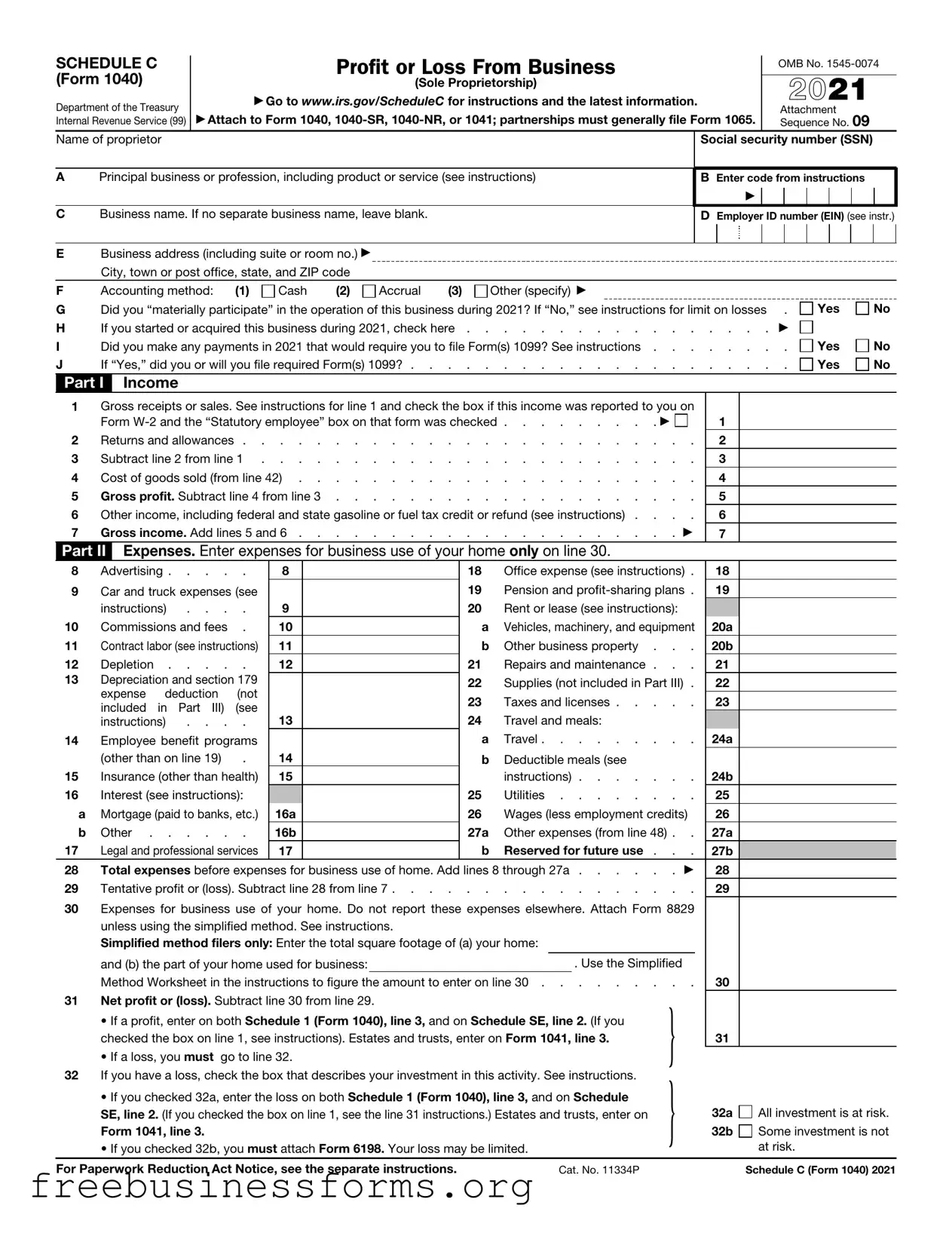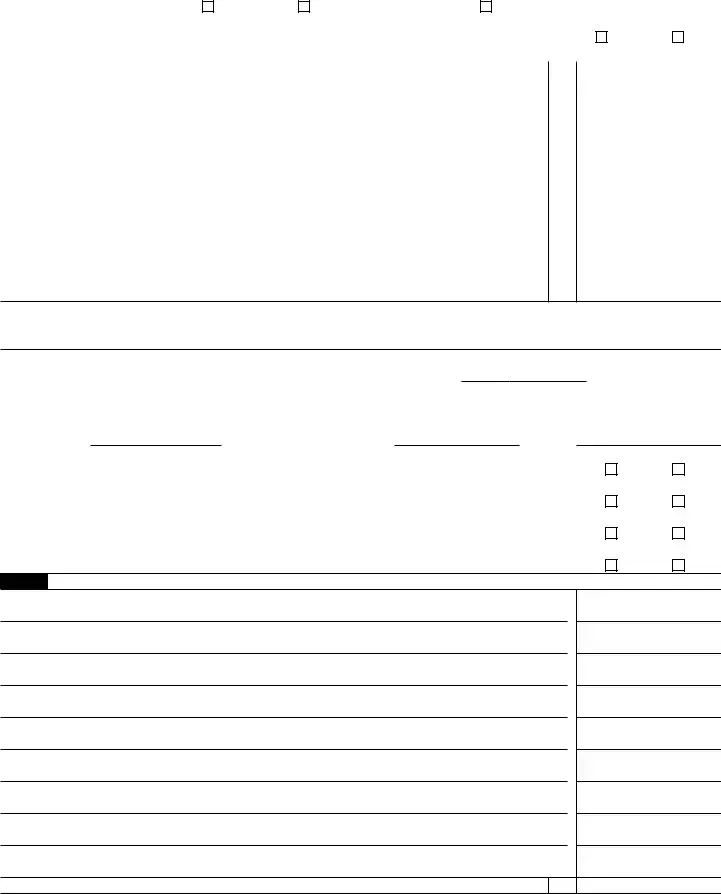|
|
|
|
|
|
|
|
|
|
|
|
|
|
|
|
|
|
|
|
|
|
F |
Accounting method: |
(1) |
Cash |
(2) |
|
Accrual |
(3) |
Other (specify) ▶ |
|
|
|
|
|
|
|
G |
Did you “materially participate” in the operation of this business during 2021? If “No,” see instructions for limit on losses |
. |
Yes |
No |
H |
If you started or acquired this business during 2021, check here |
. . |
. . |
▶ |
|
|
I |
Did you make any payments in 2021 that would require you to file Form(s) 1099? See instructions . . . |
. . |
. . |
. |
Yes |
No |
J |
If “Yes,” did you or will you file required Form(s) 1099? |
. . |
. . |
. |
Yes |
No |
Part I |
Income |
|
|
|
|
|
|
|
|
|
|
|
|
|
|
|
|
|
|
|
1 |
Gross receipts or sales. See instructions for line 1 and check the box if this income was reported to you on |
|
|
|
|
|
|
Form W-2 and the “Statutory employee” box on that form was checked |
. . . . . . . . . ▶ |
1 |
|
|
|
|
2 |
Returns and allowances |
2 |
|
|
|
|
3 |
Subtract line 2 from line 1 |
3 |
|
|
|
|
4 |
Cost of goods sold (from line 42) |
4 |
|
|
|
|
5 |
Gross profit. Subtract line 4 from line 3 |
5 |
|
|
|
|
6 |
Other income, including federal and state gasoline or fuel tax credit or refund (see instructions) . . . . |
6 |
|
|
|
|
7 |
Gross income. Add lines 5 and 6 |
. . . . . . . . . |
. ▶ |
7 |
|
|
|
|
Part II |
Expenses. Enter expenses for business use of your home only on line 30. |
|
|
|
|
|
|
|
8 |
Advertising |
8 |
|
|
|
|
|
|
18 |
Office expense (see instructions) . |
18 |
|
|
|
|
9 |
Car and truck expenses (see |
|
|
|
|
|
|
|
19 |
Pension and profit-sharing plans . |
19 |
|
|
|
|
|
instructions) . . . . |
9 |
|
|
|
|
|
|
20 |
Rent or lease (see instructions): |
|
|
|
|
|
10 |
Commissions and fees . |
10 |
|
|
|
|
|
|
a |
Vehicles, machinery, and equipment |
20a |
|
|
|
|
11 |
Contract labor (see instructions) |
11 |
|
|
|
|
|
|
b |
Other business property . . . |
20b |
|
|
|
|
12 |
Depletion |
12 |
|
|
|
|
|
|
21 |
Repairs and maintenance . . . |
21 |
|
|
|
|
13 |
Depreciation and section 179 |
|
|
|
|
|
|
|
22 |
Supplies (not included in Part III) . |
22 |
|
|
|
|
|
expense deduction |
(not |
|
|
|
|
|
|
|
|
|
|
|
|
|
|
|
|
|
|
|
23 |
Taxes and licenses |
23 |
|
|
|
|
|
included in Part III) (see |
|
|
|
|
|
|
|
|
|
|
|
|
instructions) . . . . |
13 |
|
|
|
|
|
|
24 |
Travel and meals: |
|
|
|
|
|
|
|
14 |
Employee benefit programs |
|
|
|
|
|
|
|
a |
Travel |
24a |
|
|
|
|
|
(other than on line 19) |
. |
14 |
|
|
|
|
|
|
b |
Deductible meals (see |
|
|
|
|
|
|
|
15 |
Insurance (other than health) |
15 |
|
|
|
|
|
|
|
instructions) |
24b |
|
|
|
|
16 |
Interest (see instructions): |
|
|
|
|
|
|
|
25 |
Utilities |
25 |
|
|
|
|
a |
Mortgage (paid to banks, etc.) |
16a |
|
|
|
|
|
|
26 |
Wages (less employment credits) |
26 |
|
|
|
|
b |
Other |
16b |
|
|
|
|
|
|
27a |
Other expenses (from line 48) . . |
27a |
|
|
|
|
17 |
Legal and professional services |
17 |
|
|
|
|
|
|
b |
Reserved for future use . . . |
27b |
|
|
|
|
28 |
Total expenses before expenses for business use of home. Add lines 8 through 27a |
. ▶ |
28 |
|
|
|
|
29 |
Tentative profit or (loss). Subtract line 28 from line 7 |
29 |
|
|
|
|
30 |
Expenses for business use of your home. Do not report these expenses elsewhere. Attach Form 8829 |
|
|
|
|
|
|
unless using the simplified method. See instructions. |
|
|
|
|
|
|
|
|
|
|
|
|
|
|
Simplified method filers only: Enter the total square footage of (a) your home: |
|
|
|
|
|
|
|
|
|
|
|
|
|
|
|
|
|
|
|
|
|
|
|
|
and (b) the part of your home used for business: |
|
|
|
|
|
|
|
. Use the Simplified |
|
|
|
|
|
|
Method Worksheet in the instructions to figure the amount to enter on line 30 |
30 |
|
|
|
|
31 |
Net profit or (loss). Subtract line 30 from line 29. |
|
|
|
|
|
|
|
} |
|
|
|
|
|
|
|
• If a profit, enter on both Schedule 1 (Form 1040), line 3, and on Schedule SE, line 2. (If you |
|
|
|
|
|
|
|
checked the box on line 1, see instructions). Estates and trusts, enter on Form 1041, line 3. |
|
31 |
|
|
|
|
|
• If a loss, you must go to line 32. |
|
|
|
|
|
|
|
|
|
|
|
|
|
|
|
32 |
If you have a loss, check the box that describes your investment in this activity. See instructions. |
} |
|
|
|
|
|
|
|
• If you checked 32a, enter the loss on both Schedule 1 (Form 1040), line 3, and on Schedule |
|
|
|
|
|
|
|
SE, line 2. (If you checked the box on line 1, see the line 31 instructions.) Estates and trusts, enter on |
|
32a |
All investment is at risk. |
|
Form 1041, line 3. |
|
|
|
|
|
|
|
|
|
|
|
|
|
32b |
Some investment is not |
|
• If you checked 32b, you must attach Form 6198. Your loss may be limited. |
|
|
|
at risk. |
|
|
For Paperwork Reduction Act Notice, see the separate instructions. |
|
|
Cat. No. 11334P |
|
|
|
Schedule C (Form 1040) 2021 |







